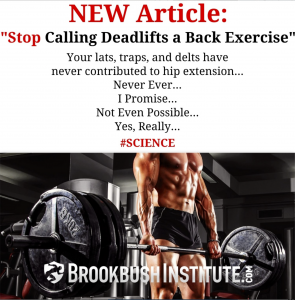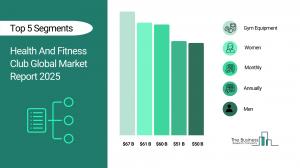Deadlifts are a great exercise for strength and hypertrophy of the hip extensors. The traps, deltoids, lats, and erectors do not contribute to hip extension.
— Dr. Brent Brookbush, CEO of Brookbush Institute
NEW YORK, NEW YORK, UNITED STATES, August 17, 2023/EINPresswire.com/ — Snippet from a NEW article by the Brookbush Institute: Stop Calling Deadlifts a “Back Exercise”
The primary joint action of a deadlift is hip extension, not lumbar extension. Your erector spinae, multifidus, latissimus dorsi, and trapezius muscles do not contribute to hip extension. These muscles are active, but they are primarily performing isometric contractions, and isometric contractions are not ideal for increasing muscle size (hypertrophy) or dynamic strength. Saying deadlifts are “good for thickening your back” is as ridiculous as saying “bicep curls are great for rounding your shoulders.”
This topic is relevant because it relates to where a deadlift should be programmed in a strength training routine. Is it a lower-body exercise or an upper-body exercise, and if you are doing a split routine, on which day should it be programmed? The answer should be obvious, but for some strange reason calling a deadlift a “lower-body exercise” is controversial. If a heavy lower-body day is done the day before or after an upper-body day, and your upper-body day includes deadlifts, a frequency and recovery issue is created. (We recently reviewed all training frequency and recovery research for the course, Acute Variables: Training Frequency and Recovery Between Sessions) It is likely that the glute complex and lumbar erectors (erector spinae and multifidus) will not have optimal time to recover, the volume of exercise will exceed the body’s ability to adapt, over-training these muscles may impede progress, and the risk of injury will have increased without the potential for additional benefits. In short, this mislabeling could result in more work, for less gain, and a higher risk of injury.
Deadlifts are a great exercise for increasing lower body strength and hypertrophy, especially the hip extensors, but hey are a poor choice for “back muscle” hypertrophy. For more deadlift variations and progressions – Deadlift Exercises and Deadlift Progressions
Quick Summary:
– The primary joint action during a deadlift should be hip extension, not lumbar extension.
– The gluteus maximus is the prime mover of hip extension; not the lumbar erectors or latissimus dorsi.
– Erector spinae EMG activity is similar for most compound lower body exercises (squats, deadlifts, lunges, etc.) when the weight is adjusted to a given repetition maximum (e.g. 1-RM).
– The latissimus dorsi can only contribute a relatively small amount of force to lumbar extension, and they do not contribute to hip extension.
– During a deadlift, the lumbar erectors, scapular stabilizers, and latissimus dorsi are maintaining an isometric contraction. Isometric contractions are likely far less effective for hypertrophy, dynamic strength, and power development when compared to dynamic contractions including an eccentric phase.
– Practical Application: Ideal training frequency is 2-3 sessions/muscle group/week, with 2-3 days rest between sessions for similar muscle groups. Performing heavy deadlifts and/or other high-intensity lower-body exercises on consecutive days is likely to inhibit progress toward strength and hypertrophy.
Relevant Research:
Andersen V, Fimland MS, Mo DA, Iversen VM, Vederhus T, Hellebø LRR, et al. Electromyographic comparison of barbell deadlift, hex bar deadlift, and hip thrust exercises: a cross-over study. J Strength Cond Res. 2018; 32(3): 587–93. pmid:28151780
McAllister MJ, Hammond KG, Schilling BK, Ferreria LC, Reed JP, Weiss LW. Muscle activation during various hamstring exercises. J Strength Cond Res. 2014; 28(6): 1573–80. pmid:24149748
Bogduk, N., Johnson, G., & Spalding, D. (1998). The morphology and biomechanics of latissimus dorsi. Clinical Biomechanics , 13 (6), 377-385
Granata, K. P., & Marras, W. S. (1995). Coactivity on Dynamic Spinal Loads. Spine , 20 (8), 913-919
Roig M, O’Brien K, Kirk G, Murray R, McKinnon P, Shadgan B, Reid WD. The effects of eccentric versus concentric resistance training on muscle strength and mass in healthy adults: A systematic review with meta-analysis. Br J Sports Med 43: 556–568, 2009.
Bamman, M. M., Shipp, J. R., Jiang, J., Gower, B. A., Hunter, G. R., Goodman, A., … & Urban, R. J. (2001). Mechanical load increases muscle IGF-I and androgen receptor mRNA concentrations in humans. American Journal of Physiology-Endocrinology and Metabolism, 280(3), E383-E390.
Farthing, J. P., & Chilibeck, P. D. (2003). The effects of eccentric and concentric training at different velocities on muscle hypertrophy. European journal of applied physiology, 89(6), 578-586.
Firoozi, H., Arazi, H. and Asadi, A. (2020) Effects of resistance training program on muscular performance adaptations: comparing three vs. four times per week. Biomedical Human Kinetics, 12, 149-156, doi: 10.2478/bhk-2020-0019
Miranda, H., Maia, M. F., Paz, G. A., de Souza, J. A. A. A., Simão, R., Farias, D. A., & Willardson, J. M. (2018). Repetition performance and blood lactate responses adopting different recovery periods between training sessions in trained men. The Journal of Strength & Conditioning Research, 32(12), 3340-3347.
Brent Brookbush
Brookbush Institute
email us here
Visit us on social media:
Facebook
Twitter
LinkedIn
Instagram
YouTube
TikTok
![]()



